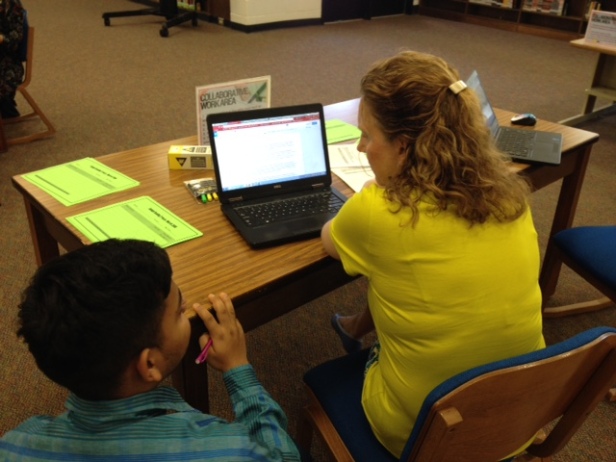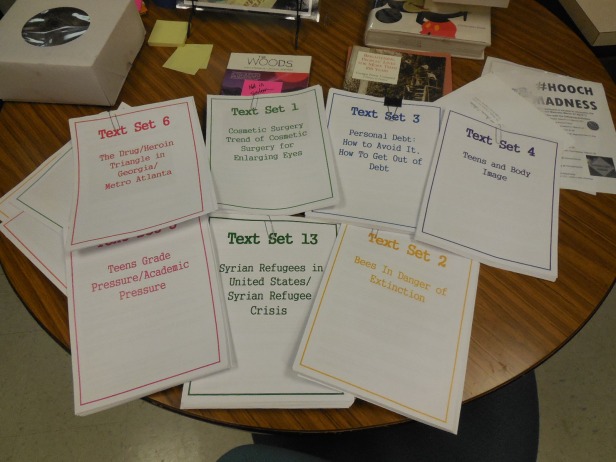Last year, Jennifer Lund and I had the pleasure of doing a reading frenzy with Language Arts teacher Sean O’Connor and his students. The concept of a reading frenzy comes from teacher and speaker Nancy Steineke. The basic premise of the activity is to give students a series of texts, allow them to skim and read fairly quickly, and then rate/rank the articles/texts they have read from most favorite to least favorite. This activity is a springboard to helping students either choose a topic or find a focal point for a topic they’ve already identified as an area of interest.
When ESOL teacher Amy Balogh approached me about helping her students with research, she wanted them to have a positive experience and to develop key skills rather than trying to blast them with too much information. We had great fun brainstorming and thinking together; ultimately, Amy decided to approach the research unit as a series of mini-inquiries infused with modeling mini-lessons as well as some light information literacy instruction with me. Because she has been implementing a writer’s workshop approach all year, she decided to use some of the mini-lessons and writing/mini-inquiry assignments from Kelly Gallagher’s Write Like This: Teaching Real-World Writing Through Modeling and Mentor Texts as the inspiration for her instructional design.
Amy decided to begin with the “5 Things You Can Do” inquiry/writing/research assignment. Each class brainstormed and decided on a top topic to explore as a class. Using a LibGuide as our “home base”, we decided to introduce the students to two of our Gale databases, Opposing Viewpoints in Context and Kids InfoBits, as our starting points for research. The students *loved* the search interface, but they especially loved the ease of citation of the articles with EasyBib. Their favorite feature, though, was the Gale integration with Google Drive. Students were super impressed with the ability to download articles directly into Google Drive for annotating or just having a digital copy of the text; they also loved the highlighting and note-taking feature and the ability to download those highlights and notes into Google Drive. This mini-lesson gave students some search tools and strategies to begin their group inquiry into their class issues like current debates around gun control and gun violence. Amy used shared documents in Google Drive to model the writing assignment from Gallagher in which they investigate the issue and then develop 5 solutions or “things you can do” about the issue. This mini-lesson gave the students some solid starting points for search, but because the students’ bigger challenge is reading and understanding informational text, we didn’t want search to be the focus of their learning experiences as we moved forward with new mini-inquiries that we wanted to use to “spiral” up the depth of student thinking. We both agreed that working with the information–reading, synthesizing, and then creating their own writing based on their research interests were the priorities. With these learning needs in mind, I felt a slowed down version of Nancy’s “reading frenzy” would be a great way to scaffold students to these goals.
Our next step was for students to choose a topic to explore individually or with a partner. Students brainstormed a diverse range of topics, and I pulled together text sets on each topic. “Texts” in each set could include articles from the web, articles from different databases, podcasts, and/or videos; for digital texts, students could use the media center iPad to watch/listen to their those texts. These texts would be a springboard to helping students then craft their own “5 Things You Can Do” mini-paper. Topics included:
- How to sleep better
- How to eat more food in a restaurant (two ideas: eating contests and getting the most for your money while dining in a restaurant)
- Decreasing junk food in schools
- How to have a good day
- Time management
- Taking care of a dog
- Growing plants
- Traveling on a budget
- How to get rich
- How to avoid major life mistakes; making smart life choices
- Healthy eating/nutrition
We gave the students two days to muck around with their text sets. I told students they could read the articles in any order, and they were also welcome to explore other text sets if something caught their eye. Each student received a green sheet to record his/her articles and how they would rate the article on a scale of 1-10. We asked students to read the articles of their choosing from their set(s) of interest and to annotate the texts as they read. We used Nancy Steinke’s text annotation codes as a supplement to the annotation strategies they had already learned earlier this year with Ms. Balogh. In addition, I provided students different kinds of sticky notes they could use to jot down notes and highlighters. They immediately jumped into their sets and immersed themselves in the readings!
Normally, students would scan and skim the articles in a shorter time frame and rank the articles based on their interest in the topics within that set; they would then begin engage in presearch and begin developing an inquiry plan around that topic. For us, our “slowed down” version of Nancy’s reading frenzy structure was to help students confirm an interest in the topic and/or further refine a focal point and narrow the big topic to a more specific scope. We did give students an opportunity to rank their favorite articles at the end of Day 2; this ranking was helpful in identifying the kinds of articles students found most helpful or interesting.
Two things really struck me about this first round of the slowed down reading frenzy with Amy’s students. First, they were incredibly engaged and involved with their texts—whether they were discussing the articles, reading intently and annotating, jotting notes on the sticky Post-It pads, or asking Amy specific questions about a text for clarification, the students were soaking up the text sets. Secondly, the camaraderie among the students in each class was inspiring to observe. Amy has clearly cultivated a classroom culture of care and empathy, and the students really function as a true learning community. Whether they were helping each other with a text, sharing an idea, or thinking through an idea with a partner,the rapport was genuine. In many ways, the feel of the class is reflective of the practices of participatory learning; I think this culture of learning is so vital for meaningful learning experiences.
For our second mini-inquiry, Amy introduced the problem-solution writing task from Kelly Gallagher’s book and modeled this in person using a shared Google Doc with the students. Once again, students generated topics of personal interest, and I put together text sets to get them started:
- Cosmetic surgery–blepharoplasty or double eyelid surgery–with young people, especially in Korea
- Bees in danger of extinction
- Teens – body image
- Teens – grade pressures
- Drugs and teens/the heroin epidemic in the “Triangle” in metro Atlanta
- Teen dependency/ over-dependency on phones
- Hours in a school day, changing the start time of the school day in relation to teens needing more sleep; also decreasing school day
- Time management
- Improving school cafeteria; better school cafeteria design
- Bullying and teens
- Teens and suicide
- Poor/poverty and education – in US
- Refugee crisis – Syria – US
- Personal debt
- Getting into college–admissions policies for Georgia schools
With both “slowed down” reading frenzies, there was always 1-2 students who were still struggling with a topic; sometimes they were able to think of something on their own, but other times, they discovered a path to a topic by exploring the existing text sets. Again, we gave students two complete days to immerse themselves in the text sets; they also had choice in where they wanted to sit and the table/seating arrangements.
Reflections
Here are some of the grows and glows about the activity from Ms. Balogh’s students:
As you can see, the students felt the activity helped them move forward with the information they needed to dwell in the thinking, composing, and idea development processes they did in their mini-papers. As one student pointed out in the “grows”, we definitely need to add some nonfiction and/or informational texts in print, particularly ones that are more varied in reading levels so that there is something for all learners. This area of development is one of our collection goals for 2016-17.
Amy shared these reflections on the work we’ve done for the last month:
My struggle in the past with the ESOL students and research is that it’s challenging to find articles that are both “scholarly” and are at an accessible reading level. Also, it is difficult for the students to skim articles when searching for them to see if they are actually helpful. This activity eliminated problem. I’m more concerned with them actually READING good articles that help them, instead of spending a lot of time trying to FIND articles to read. My favorite quote from this activity was when one student said, “this really made me think.”
I have thoroughly enjoyed my time with Amy and her students over the last few weeks, and it has been joyful to see the students happily engaged with their topics. I am deeply appreciative that Amy puts student curiosity and choice at the center of the learning experience; clearly, that focus has yielded student growth. She has supported students with regular modeling of writing and thinking processes, and I am happy I could be part of fostering learning experiences to scaffold students’ engagement with their topics. Now that we have a solid foundation established, we can begin looking to 2016-17 and thinking about ways to fold in more mini-inquiries throughout the year so that we can build search skills as well as informational text reading strategies. I am looking forward to further collaboration with Amy and her students and new opportunities for us to provide learning experiences that will help students grow not only their reading and writing literacies, but their digital and information literacy skills as well!
















What a great activity! I’m a Kelly Gallagher fan. Can you share the green rate sheet and any other materials you used. Thank you!
LikeLike
My students and staff have been loving the magic of Gale/Google Drive integration as well. It’s such a simple thing that completely transformed the way we have done parts of our research. Thanks for sharing the idea of starting with articles . . . gives me something to ponder for my next attempt.
LikeLike